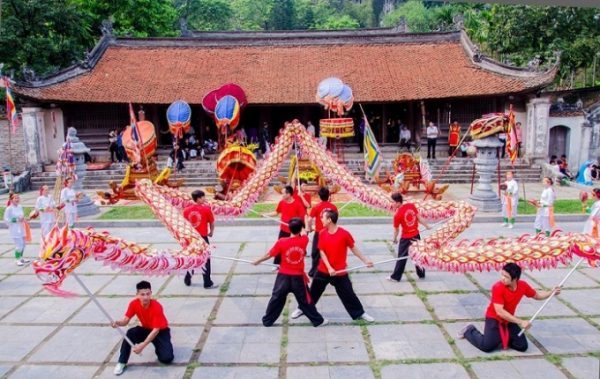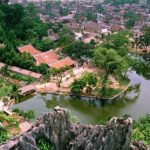In the coming years, Quoc Oai District will carry out master planning for the Special National Relic Site of Thay Pagoda and the mountainous areas of Sai Son, Hoang Xa, Phuong Cach for the embellishment of relic items in order to preserve cultural values and serve for spiritual tourism exploitation at the relic site.
In implementing Program No. 4 of Hanoi Municipal Party Committee on “Developing culturally and socially, enhancing the quality of human resources of the capital city, creating the impression of elegant and civilized behaviors of Hanoians” in the period 2016-2020 and the contents of the resolution issued at the 22nd meeting of the Party Committee of Quoc Oai District for the period 2015-2020 on cultural development commensurate with economic development, Quoc Oai District will carry out master planning for the Special National Relic Site of Thay Pagoda and reform the way of managing and organizing traditional festivals to preserve spiritual values, rituals, and folk games of Quoc Oai people.
Thay Pagoda is a relic complex carrying a bountiful collection of historical, cultural and architectural values, most noticeable in the unique carvings and the long-standing statue system at the site. Thay Pagoda was recognized as a national relic site in 1962 and a special national relic site in 2014. This place attracts a yearly number of tens of thousands of tourists visiting to offer incense to the Buddha, go for sightseeing, or explore the beauty of the caves. Over time, many items within the relic complex show signs of deterioration and need to be embellished.

Thay Pagoda carries spiritual values that need to be preserved and promoted
(Photo by Phung Anh Tuan)
The task of master planning for the Special National Relic Site of Thay Pagoda and the mountainous areas of Sai Son, Hoang Xa, and Phuong Cach is considered an urgent task. The district will relocate 47 households living around Long Tri Lake at the foot of Thay Mountain to a new resettlement area to ensure the protection belts planned for the relic complex are not populated by residents. The ceremonies featuring a variety of special rituals of the Mizong school will be held in the center area, separately from the organization of festivals and service activities which will take place outside of the relic complex, ensuring the integrity of the infrastructure and the sacredness and mystery of the relics. The district also plans to open a road from the tourist belt to Long Dau Pagoda and move the parking lot to outside of the center of the relic complex. These will contribute to preserving the architectural features while ensuring the renovation and embellishment of the relic complex’s core items are in accordance with the provisions of the Heritage Law. The total planned area is 100 hectares, including items such as the communal house, the pagodas, the temples, the limestone mountain system, and service infrastructure for sightseeing, tourism, religious and spiritual activities, and entertainment at the relic site of Thay Pagoda and the mountainous areas of Sai Son, Hoang Xa, and Phuong Cach.

A lion dance performance at a traditional festival (Photo: Internet)
In the coming time, Quoc Oai District will set out specific objectives and directions to upgrade the Special National Relic Site of Thay Pagoda to promote the relic complex’s values. Such regulations will include the standardization of printed materials and forms of introduction and promotion programs; the standardization of tour guides; the organization of promotional programs to promote Thay Pagoda and brands of tourism products; and the development of cultural and spiritual products such as tuong (classical drama), cheo (satirical theatre), martial arts, wrestling, traditional singing, puppetry, and folk games. The District People’s Committee has assigned the Office of Culture and Information to build a scheme on “Promoting the National Relic Site of Thay Pagoda in the period 2018-2020 and the following years”.
Regarding the management and organization of festivals, the District People’s Committee has set up a relic management board to manage the ticketing, the sales activities, the guidance for sightseeing, and other auxiliary tasks at the festivals to deliver positive changes in the management of relic sites and tourism. The board will also be responsible for completely preventing the soliciting and harassment of tourists, addressing problems regarding fence roofs causing loss of aesthetics, placing clear signposts about the attractions, removing incense bowls inappropriately placed on the mountains and at the entrances to the caves, and ensuring sanitation at the relic complex in order to create a neatly maintained, green, clean, and beautiful landscape.
Minh Trang

